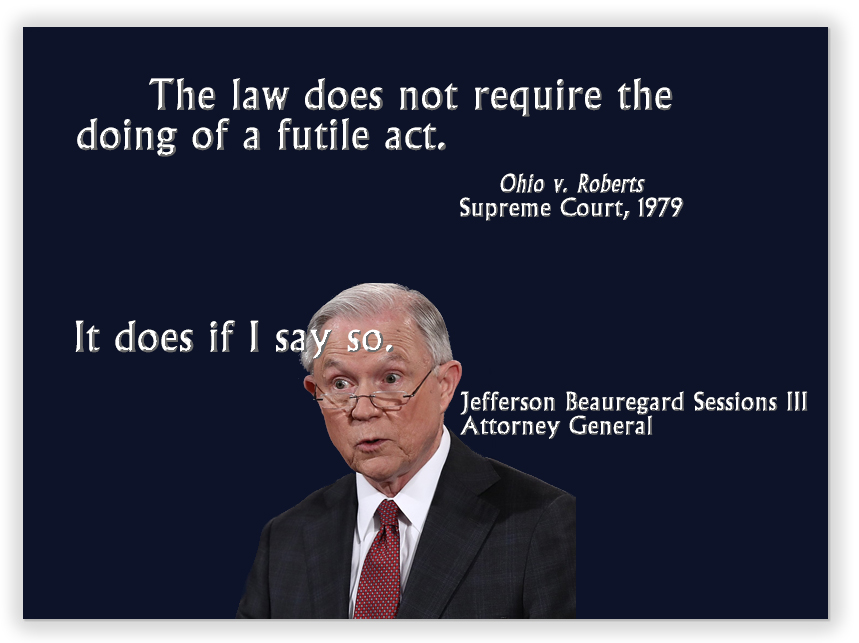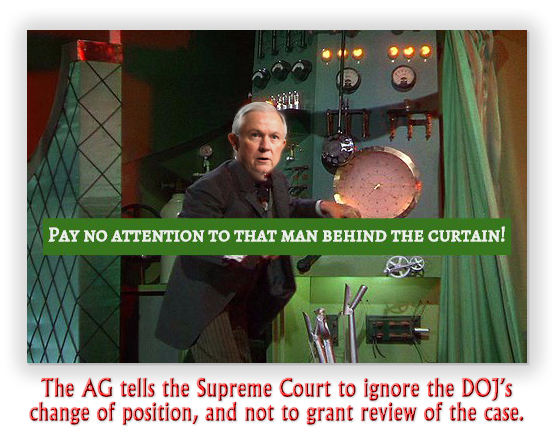We post news and comment on federal criminal justice issues, focused primarily on trial and post-conviction matters, legislative initiatives, and sentencing issues.
DOJ’S NOT JUST INCONSISTENT, IT’S GUTLESS AS WELL

Anyone who wonders where Attorney General Jefferson Beauregard Sessions III will take the Dept. of Justice has to look no further than a brief filed last month in McCarthan v. Collins.
Late last July, we wrote about McCarthan, which deals with when and under what terms an inmate may use a 28 USC 2241 motion. Recall that every inmate gets to file one motion under 28 USC 2255, but only one: filing a second 2255 motion requires prior approval of a court of appeals, which is granted only in unusual circumstances.
One such circumstance is a new Supreme Court ruling changing a constitutional rule and made retroactive. The 2015 Johnson decision, that declared part of the Armed Career Criminal Act unconstitutional, is the most recent example of such a case.
But sometimes changes in the law are not based on the constitution, like a 1995 Supreme Court decision holding that the lower courts had been misinterpreting 18 USC 924(c) – which punishes using a gun in a crime of violence or drug offense – and locking up people to whom the statute did not apply. The decision was purely one of statutory interpretation, with no constitutional dimension at all. Because of that, people who had already filed a 2255 motion were prohibited from filing another one, because the nonconstitutional change in the law did not qualify them for a second 2255.
For that kind of problem, 2255 has a “saving clause” at 28 USC 2255(e), which provides that a prisoner may use the other form of federal habeas corpus – a petition under 28 USC 2241 – if it “appears that the remedy by [2255] motion is inadequate or in-effective to test the legality of his detention.”

For the past 20 years, prisoners have been allowed to use 2241 to challenge convictions that suddenly became non-convictions because statutes had been reinterpreted in such a way that the inmates were no longer guilty of a crime. And what could make more sense? If a guy has been locked up for a decade, and he already used up and lost his 2255 motion nine years before, does that make it fair to keep him in prison another 10 years for something that’s no longer a crime?
Many years ago, Dan McCarthan walked away from a halfway house, a mistake that caught him an escape charge. At the time Dan was convicted of a felon-in-possession gun charge, all escapes were deemed to be violent, and that got him 15 years under the ACCA. But then, in 2009, the Supreme Court held escape was not a violent crime. Because the decision was based on interpreting the statute and not the constitution, it did not entitle Dan to file a second 2255, so he filed a 2241.
The district court threw out Dan’s 2241, but a three-judge panel on the 11th Circuit held he was entitled to seek review using that petition. Then, the Circuit decided to rehear Dan’s case en banc, and told the parties to brief the question of whether the 2241 was even usable in this kind of case.
 The Circuit – by a 7-4 vote last March, with six different opinions totaling more than 150 pages – held that an initial Section 2255 motion is an adequate and effective remedy to “test” a sentence, even when circuit precedent forecloses the movant’s claim at the time of the motion. After all, the Circuit said, a movant could have asked the court of appeals to overrule its precedent, sought Supreme Court review, or both. The en banc decision asserted the saving clause in Section 2255(e) is concerned only with ensuring that a person in custody has a “theoretical opportunity” to pursue a claim, even if, at the time of the initial 2255 motion, the claim was virtually certain to fail in the face of adverse precedent. In other words, you have to raise arguments even when the court has already said the arguments are futile.
The Circuit – by a 7-4 vote last March, with six different opinions totaling more than 150 pages – held that an initial Section 2255 motion is an adequate and effective remedy to “test” a sentence, even when circuit precedent forecloses the movant’s claim at the time of the motion. After all, the Circuit said, a movant could have asked the court of appeals to overrule its precedent, sought Supreme Court review, or both. The en banc decision asserted the saving clause in Section 2255(e) is concerned only with ensuring that a person in custody has a “theoretical opportunity” to pursue a claim, even if, at the time of the initial 2255 motion, the claim was virtually certain to fail in the face of adverse precedent. In other words, you have to raise arguments even when the court has already said the arguments are futile.
Prior to the 11th Circuits’s decision in Dan’s case, only the 10th Circuit took such a draconian view of the saving clause. But now, the circuit split is 9-2, and thousands of federal inmates are shut out of relief.
Dan filed a petition for writ of certiorari with the Supreme Court last summer, asking the Court to resolve the circuit split by ruling that the 2255 savings clause was intended to throw a lifeline to someone who never had a reasonable chance because circuit precedent foreclosed his argument. He argued that “the conflict on the question presented cries out for the Court’s intervention. The arguments on both sides of the conflict are well developed, with the benefit of numerous opinions across nearly every regional circuit over the last two decades. There is little room for the law to develop further… This case satisfies all of the criteria for the Court’s review, and the petition for a writ of certiorari should therefore be granted.”
This is where the plot thickens. For the last 16 years, the Justice Department had taken the same view held by Dan and 9 out of 12 circuits. DOJ even said so in at least 11 separate Supreme Court filings. But that was then. This is now, and now, the AG wants to have it both ways.
DOJ told the Supreme Court that it no longer believed that federal prisoners serving longer prison terms than the law allowed were entitled to challenge their sentences in court, because they could have raised the issue themselves years before (when their chance of prevailing was theoretical at best and located somewhere between slim and none).
 That change of position alone is duplicitous, but the next part is downright gutless. Given the fact of a substantial circuit split, you might be forgiven for thinking that DOJ would suggest the Supreme Court should take this case to settle the issue. But instead, Sessions’ department doesn’t want the Supremes to touch it, even though the DOJ brief acknowledges that the legal question is significant and that its new position could condemn inmates to serve out unlawful sentences.
That change of position alone is duplicitous, but the next part is downright gutless. Given the fact of a substantial circuit split, you might be forgiven for thinking that DOJ would suggest the Supreme Court should take this case to settle the issue. But instead, Sessions’ department doesn’t want the Supremes to touch it, even though the DOJ brief acknowledges that the legal question is significant and that its new position could condemn inmates to serve out unlawful sentences.
Last week, The New York Times observed that “it is one thing for a new administration to switch sides in a legal dispute. That is merely unusual. It is another to urge the Supreme Court to deny review in a case that would test whether the government’s new position is correct.”
Dan’s petition is scheduled to be considered at the Supreme Court’s conference on Friday, December 1. It could be decided then or get relisted for one or more subsequent conferences.
New York Times, Serving Extra Years in Prison, and the Courthouse Doors Are Closed (Nov. 20, 2017)
– Thomas L. Root

